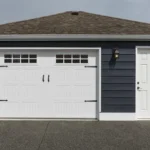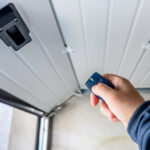How to Fix Garage Door Sensor
First off, we need to highlight the importance of the garage door sensor. It serves multiple purposes, warning off intruders with its LED lights and helping you know when the door has been opened. But when those sensors start acting up, it can be really frustrating. You press the button, but nothing happens. Your garage door refuses to budge, leaving you standing there, wondering what happened and why is your garage sensor not working.
Understanding how to fix automatic garage door sensors can save you some time and money while bringing things in order. In this blog post, we’ll walk you through some simple steps and common reasons for garage door sensors to malfunction. If you, however, still need help, we’ll show you where to go.
Check if the Safety Sensors Are Aligned
Whether we’re talking about a commercial or a residential garage, one of the first things to check when your automatic garage door isn’t responding is the proper alignment of its sensors. These devices are usually located near the base of each side of the garage door frame.
When they’re properly aligned, an invisible infrared beam connects them. If there’s an issue, such as wrong garage door sensor alignment, they won’t work as intended. This often leads to frustrating situations where you press the button and nothing happens. So how to align garage door sensors?
First, look closely at both sensors to check if they’re properly aligned. They should be facing directly toward each other, with no obstruction in between. You can gently adjust one or both until they line up perfectly.
Sometimes even minor shifts can disrupt this connection, so make sure they’re secure but not too tight. Once aligned, try testing the door again to see if it responds correctly this time around.
Check if the Sensors Are Dirty
If the garage door safety sensors are dirty, they can malfunction or fail entirely. Dust, dirt, and collected debris over time can obstruct the safety sensors’ ability to communicate effectively.
Start by visually inspecting both sensors located at the bottom of your garage door tracks. Look for any visible grime that could be the cause of dirty lenses. If you notice anything, gently wipe down the sensor lenses using a soft, clean cloth or paper towel. Avoid using harsh chemicals, as plain water usually does the trick.
After cleaning, test the door again to see if it operates smoothly. A simple cleaning of the garage door frame might be all you need for proper functionality.
Check the Garage Door Sensors’ Wiring
A damaged or loose wire can lead to erratic behavior, such as garage door sensors blinking red or completely failing to function. To check if this is the issue, first visually observe the wires connected to each sensor. Look for any fraying, cuts, or exposed sections that might indicate a garage door sensor problem. These issues can often disrupt communication between the sensors and the garage door openers.
Next, ensure that all connections are secure. Loose connections may cause intermittent faults that could be mistaken for alignment issues. If you find signs of wear or damage, consider replacing the affected electric wires as soon as possible. A disconnected wire or a faulty one can cause issues.
Of course, before starting any such task, think about safety when handling electrical components. Unplug your system before inspecting it, and always wear protective gear.
Check the Power Supply
Your garage door sensors must have a reliable power supply to function properly. If they are not receiving adequate power, they may fail to operate as intended.
First of all, examine the outlet where the garage door opener is plugged in. Test another device in that outlet to ensure it’s working. A faulty outlet could be the source of your issue.
Next, check any extension power cords or surge protectors you might be using. Sometimes, these show signs of damage or are overloaded and may disrupt power flow.
If all looks well at the outlet level, turn your attention to the circuit breaker box. A tripped breaker can also prevent proper operation, so simply reset it if necessary.
How to Bypass Garage Door Sensors
When garage door sensors malfunction, bypassing them can be a tempting solution. However, you should understand the implications before proceeding.
To bypass the sensors, you typically need to locate their wiring. This involves disconnecting the wires from the sensor or using a jumper wire to create a continuous circuit. While this method might allow your garage door to operate without safety features, it poses significant risks. You lose the protection against potential accidents and dangerous situations.
If you’re considering this option for any reason, think twice about safety first. It’s advisable only as a temporary fix while waiting for professional repairs.
How to Replace Garage Door Sensors
If you’re unwilling to try bypassing the sensor and you don’t want to waste time repairing it, you can replace it entirely. This is straightforward and can be done with a few basic tools. To get started, you’ll need:
- Screwdriver
- Wire cutters/strippers
- Adjustable wrench
- Replacement sensors (make sure they’re compatible with your garage door opener)
- Electrical tape (optional)
First, it’s important to disconnect the power to the garage door opener by unplugging it or switching off the circuit breaker. This will ensure your safety while working on the sensors. As mentioned, the sensors are usually located on either side of the garage door, about six inches above the ground.
Once you’ve located them, you can remove the old ones by unscrewing them from their brackets. Disconnect the wires carefully, and note how they are connected, or take a picture for reference.
After that, you’re ready to install the new sensors. Mount the new sensors in the same spots as the old ones and connect the wires as before. Typically, black wires connect to black and white wires to white wires. You can twist them together and secure them with wire nuts, using electrical tape if you want extra protection.
You should make sure that the new sensors are correctly aligned, as they must communicate. Most sensors have small indicator lights that will light up when properly aligned. Once everything is connected, you can restore power to the garage door opener and test the system by opening and closing the door.
Make sure the door stops if something passes between the sensors. If the sensors aren’t working correctly, you may need to adjust their positions slightly until the green lights are steady, which indicates proper alignment.
Who Can I Call For Help?
Speaking of garage door repair services, it might be time to reach out for professional garage assistance if you’ve tried all of the above, but nothing seems to work. Independence Garage Doors has trained garage door technicians who can quickly diagnose and fix any issues you may not be able to address yourself.
Regardless of the type of garage door, we offer estimates and ensure fair prices. When you’re stressed, we don’t add to it, but ensure you receive professional help with garage door installation and repairs. Whether it’s an emergency or routine maintenance, we offer reliable support throughout all your issues. We’re employing professional safety standards, so you can be sure that the job is done properly. Don’t hesitate to get in touch with out top-notch quality customer service.










Leave A Comment